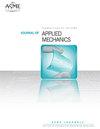装药成型弹丸弹道性能的数值研究
IF 2.8
4区 工程技术
Q2 MECHANICS
引用次数: 0
摘要
本文对聚能装药冲击过程进行了数值分析,研究了射流的形成过程及其对金属靶的穿透性能。将数值结果与已发表文献中铜和铁内衬的实验数据进行了比较。采用有限元方法模拟了不同构型的锥形和碗状衬管几何形状,以观察其对弹丸形状和穿透能力的影响。爆炸成型弹丸在撞击开始时的确切形状被建模为刚性三维物体,以模拟穿透过程#使用45和Armox 500T钢作为目标材料,并使用Johnson Cook(JC)塑性和损伤模型对材料行为和失效机制进行建模。除了有限元方法外,还利用光滑粒子流体动力学(SPH)来评估其预测金属靶失效行为的能力。结果表明,有限元方法在预测失效模式方面优于SPH方法,而SPH方法仍可用于预测残余速度和孔径。与#45钢相比,Armox 500T具有更高的抗冲击性。发现衬管几何形状会显著影响穿透性能。由具有小锥角的内衬形成的更锋利、更薄的射弹被证明在穿透装甲钢目标方面是高效的。本文章由计算机程序翻译,如有差异,请以英文原文为准。
A numerical study on the ballistic performance of projectiles formed by shaped charge
In this work, a numerical analysis of shaped charge impact process is conducted to investigate the jet formation process and its penetration performance on metal targets. Numerical results are compared with experimental data from published literature for liners made up of copper and iron. Conical and bowl-shaped liner geometries are simulated with various configurations to observe their effects on projectile shape and penetration capability using the finite element (FE) method. The exact shape of the explosively formed projectile at the onset of impact is modeled as a rigid 3D body to simulate the penetration process. #45 and Armox 500T steels are used as the target materials, and the material behavior and failure mechanisms are modeled using the Johnson-Cook (JC) plasticity and damage models. In addition to the FE method, smoothed particle hydrodynamics (SPH) is utilized as well to evaluate its capacity in predicting the failure behavior of the metal targets. It is concluded that the FE method outperforms the SPH method at predicting failure modes while SPH can still be used to predict residual velocity and hole diameters. Armox 500T demonstrates a higher impact resistance compared to #45 steel. Liner geometry is found to significantly affect penetration performance. Sharper and thinner projectiles formed from liners with small cone angles are shown to be highly efficient in penetrating through armor steel targets.
求助全文
通过发布文献求助,成功后即可免费获取论文全文。
去求助
来源期刊
CiteScore
4.80
自引率
3.80%
发文量
95
审稿时长
5.8 months
期刊介绍:
All areas of theoretical and applied mechanics including, but not limited to: Aerodynamics; Aeroelasticity; Biomechanics; Boundary layers; Composite materials; Computational mechanics; Constitutive modeling of materials; Dynamics; Elasticity; Experimental mechanics; Flow and fracture; Heat transport in fluid flows; Hydraulics; Impact; Internal flow; Mechanical properties of materials; Mechanics of shocks; Micromechanics; Nanomechanics; Plasticity; Stress analysis; Structures; Thermodynamics of materials and in flowing fluids; Thermo-mechanics; Turbulence; Vibration; Wave propagation

 求助内容:
求助内容: 应助结果提醒方式:
应助结果提醒方式:


